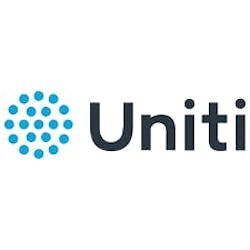Uniti’s hyperscaler fiber service sales funnel continues to grow
Key Highlights
- Uniti’s hyperscaler contract value exceeds $1.7 billion, reflecting a surge in AI infrastructure demand.
- The company has increased its total addressable market estimate for AI and hyperscalers by 50%, indicating strong growth potential.
- Uniti is pursuing both greenfield fiber builds and leveraging existing network capacity to meet hyperscaler needs.
- The merger with Windstream enhances Uniti’s network assets and ability to sell optical wavelength services, especially in less competitive Tier 2 and Tier 3 markets.
- Fiber revenue grew 13% year-over-year, with Kinetic consumer fiber revenue increasing by 26%, demonstrating robust market performance.
Keep up to date with Lightwave’s second-quarter earnings coverage.
You can check our publication’s key segments:
· Optical
And
For more on Uniti:
Uniti likes its position to compete for fiber wholesale services in the hyperscaler market, so much so that the service provider has raised its revenue targets for the market that is seeing a surge in demand due to emerging AI applications.
In its third-quarter presentation, Uniti noted that the combined Uniti and Windstream hyperscaler funnel represent over $1.7 billion of total contract value. This is driving the service provider to actively pursue various new hyperscaler opportunities.
The company sees its hyperscaler activity as a percentage of its total funnel. At the stand-alone Uniti has improved materially year-over-year to around 30% of recurring revenue (MRR).
Speaking to investors during its third quarter earnings call, Kenny Gunderman, CEO of Uniti, said its sales opportunity has increased 13%sequentially, with several large deals getting booked but being replenished with many more.
“We now believe the total addressable market for AI and hyperscalers for fiber providers is approximately 50% higher than what we originally estimated at the beginning of this year,” he said.
Gunderman added that his outlook is based on a mixture of new bookings as well as conversations with its customers.
“Our customers continue to say to us both privately and publicly that investing in AI infrastructure is mission-critical to their businesses,” he said. “For Uniti, the next few quarters will likely bring the largest deals we have seen to date, and we have clear visibility into at least 3 years of strong value-accretive deal flow.”
Hyperscaler incremental TAM
While Uniti initially adopted a conservative look at the total addressable market (TAM) for the hyperscaler opportunity, the escalating investment in compute and model capabilities, combined with hyperscalers raising historical levels of AI capital investment, is driving it to raise its incremental total addressable market (TAM) outlook.
Other factors include investments from two other groups: superscalers (e.g., X, Tesla, OpenAI, ByteDance) and Neocloud Players (e.g., Anthropic, Lamda, Coreweave), and outside capital and partnerships (e.g., Blue Owl / Meta, NVIDIA / OpenAI, Oracle), making large investments.
“When we estimated hyperscaler TAM back at the beginning of this year, we used all the data we had available, and we came up with those numbers and thought that they were fairly conservative at the time,” Gunderman said. “When you fast forward to today, I think the real takeaway from the page is not necessarily the aggregate numbers. It's just the increase in bullishness that we see for ourselves, and that 30% to 50% is a good indicator of that because when we look at those aggregate numbers and compare them to the same kind of data points we started with back at the beginning of the year, they look even more conservative.”
He added that Uniti’s customers are telling them privately and publicly that “demand is outpacing supply.”
“We've sold mega strand counts, 432-strand counts, and we've had the same customer come back and ask for another 432-strand count,” Gunderman said. “That's just a very bullish data point on demand outpacing supply. They talk about how the AI infrastructure is mission-critical to their businesses.”
When it comes to addressing hyperscaler opportunities, Uniti sees a “gray line” between the training and inference phase. The training phase is the foundational step in the AI model lifecycle where hyperscalers (large-scale cloud providers like Google, Amazon, and Microsoft) use large amounts of data and computational power to build and develop large language models (LLMs). This phase is distinct from the subsequent "inference" or production phase.
Gunderman said that he sees potential in all phases of hyperscalers to sell more of its fiber-based solutions.
“Based on conversations with our customers, these training models are going to need to be updated on a very regular basis, including with Agentic AI and all the other use cases that we're seeing,” he said. “And so, we're really excited about the builds that we've put in place today to enable these training data centers and feel like there's going to be the second and the third, and the fourth comeback for additional fiber to enable those data centers.”
As it pursues new fiber network deals with hyperscalers, Uniti is seeing an opportunity to pursue greenfield builds as well as those that can leverage current network facilities.
“The deals that we're seeing from hyperscalers always run the spectrum all the way from greenfield builds with very high Network Revenue Contracts (NRCs),” Gunderman said. “And we love those deals where we're building strategic fiber. But also, on the very other end of the spectrum, we're selling existing capacity or existing network, either in waves or dark fiber IRUs or in leases. And we think that's going to continue.”
Optical wavelength opportunities
While Uniti has gained momentum in data centers, selling dark fiber solutions, the service provider is also moving to provide optical wavelength services.
Having a market share of what it estimates to be less than 5% in the wavelength market, Uniti’s growth potential could be large, as it can now leverage the larger network it has through its merger with Windstream.
Gunderman sees an opportunity to target opportunities on what he calls unique routes on its network. Uniti sells an array of wavelength services with various bandwidths (1G, 2.5G, 10G, 100G and 400G and interface options (Ethernet, optical, and SONET)
“We’re starting to get into the wave market because we definitely began to recognize that there are unique routes on our network,” he said. “Lighting those unique routes, similar to how we target Tier 2 and Tier 3 markets, could be an opportunity for us to take share, especially as more and more new fiber is being built around the country.”
Having identified the wavelength opportunity, the merger with Windstream enhances its ability with not only additional network assets but also teams that understand how to sell these services.
Gunderman said its approach to selling wavelengths is different than the traditional method of selling in Tier 1 markets, where three or four providers tend to compete on price; it is focused on “where we've got unique infrastructure.”
“We think there's an opportunity for us going forward, building upon the original thesis, which is that we think there's going to be more wave traffic needed in less traffic markets today, meaning Tier 2 and Tier 3 routes,” he said. “And we think more and more of the hyperscalers and other Neoclouds, superscalers are going to need waves.”
He added Customers in these markets tend to purchase based upon route diversity, unique routes, and reliability, and the ability to provide good customer service, all things that we're seeing on the build side with these customers today.”
Fiber infrastructure, Kinetic leads revenues
With its Windstream acquisition behind them, Uniti saw strong results across its consumer, wholesale and business units during the third quarter.
The company reported that consolidated fiber revenue grew 13% year-over-year, while Kinetic consumer fiber revenue grew 26%.
Kinetic contributed $360.3 million in revenues and $155.4 million of contribution margin for the third quarter of 2025. Uniti’s Kinetic net capital expenditure during the quarter was $148 million.
Likewise, fiber Infrastructure contributed $227 million of revenues and $158 million of contribution margin for the third quarter of 2025. Fiber Infrastructure’s net capital expenditure during the quarter was $48 million.
Finally, Uniti Solutions contributed $136 million in revenues and $72.2 million of contribution margin for the third quarter of 2025. Uniti Solutions’ net capital expenditure during the quarter was $4.9 million.
Uniti reported consolidated third-quarter revenues of $723 million.
Net income includes a one-time gain of $1.67 billion related to the settlement of preexisting relationships in connection with the company’s merger with Windstream.
For related articles, visit the Business Topic Center.
For more information on high-speed transmission systems and suppliers, visit the Lightwave Buyer’s Guide.
To stay abreast of fiber network deployments, subscribe to Lightwave’s Service Providers and Datacom/Data Center newsletters.
About the Author
Sean Buckley
Sean is responsible for establishing and executing the editorial strategy of Lightwave across its website, email newsletters, events, and other information products.


